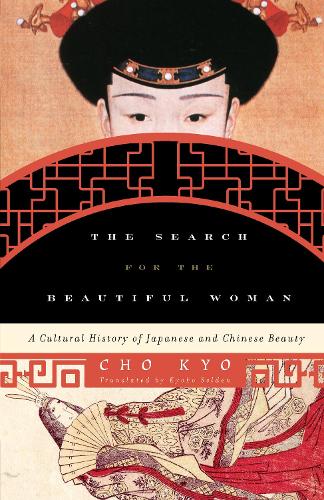
The Search for the Beautiful Woman: A Cultural History of Japanese and Chinese Beauty
(Hardback)
Publishing Details
The Search for the Beautiful Woman: A Cultural History of Japanese and Chinese Beauty
By (Author) Cho Kyo
Translated by Kyoko Iriye Selden
Bloomsbury Publishing PLC
Rowman & Littlefield Publishers
12th October 2012
United States
Classifications
Professional and Scholarly
Non Fiction
Regional / International studies
Gender studies: women and girls
305.40952
Physical Properties
Hardback
302
Width 161mm, Height 235mm, Spine 29mm
644g
Description
While a slender body is a prerequisite for beauty today, plump women were considered ideal in Tang Dynasty China and Heian-period Japan. Starting around the Southern Song period in China, bound feet symbolized the attractiveness of women. But in Japan, shaved eyebrows and blackened teeth long were markers of loveliness.
For centuries, Japanese culture was profoundly shaped by China, but in complex ways that are only now becoming apparent. In this first full comparative history of the subject, Cho Kyo explores changing standards of feminine beauty in China and Japan over the past two millennia. Drawing on a rich array of literary and artistic sources gathered over a decade of research, he considers which Chinese representations were rejected or accepted and transformed in Japan. He then traces the introduction of Western aesthetics into Japan starting in the Meiji era, leading to slowly developing but radical changes in representations of beauty. Through fiction, poetry, art, advertisements, and photographs, the author vividly demonstrates how criteria of beauty differ greatly by era and culture and how aesthetic sense changed in the course of extended cultural transformations that were influenced by both China and the West.
Reviews
In this ambitious volume Professor Cho, one of Japan's most knowledgeable scholars of comparative cultures, takes up the timeless topic of female beauty from the perspectives of China, Japan, and the West. At ease with a rich variety of literary and visual materials from all eras of Chinese and Japanese history, the author offers learned insights into classic tropes of East Asian female beauty and their encounter with Western aesthetics in modern times. Readers in many fields will find much to engage their imaginations here. -- Thomas R. H. Havens, Northeastern University; author of Radicals and Realists in the Japanese Nonverbal Arts
The study of comparative literature has been characterized by the interdisciplinary approach combining literature and art, and this book is an outstanding example of the practice. . . . The authors comparative study of Chinese and Japanese depictions of beauty from ancient times through Medieval and early modern to modern times is superb. . . . Another great contribution this book makes is clarification of cultural backgrounds based on similarities and differences observed in iconographic expressions of feminine beauty.
(Praise for the Japanese Edition)
[The author], who was lured by the eternal enigma called the beautiful woman into authoring this great opus, is at once a scholar and a poet at heart. . . . The question inspired him to carefully range through literary history, art history, and the history of everyday life in both countries.
(Praise for the Japanese Edition)
The Search for the Beautiful Woman is a scholarly, enjoyable historical exploration of the beautiful woman in two neighboring Asian cultures. Kyoko Selden, recently deceased, must be commended for clarifying layered references in Chinese, Japanese, English and other languages in her translation * Japan Times *
In his "search for the beautiful woman," Cho (comparative culture and literature, Meiji Univ., Japan) demonstrates an extensive knowledge of East Asian literature and aesthetics. Concentrating on the Warring States, Song, late Ming, Heian, Kamakura, and Edo periods, he delves into rarely discussed topics: how "good looks changed in Chinese history" and how "ethnic cultures influenced women's aesthetic sense." The comparison of Chinese with Heian era literature in chapter 5 best explains the argument of distinctly national ideas of what constitutes beauty: the author's use of Michizume's manipulating Chinese literature to reflect a Japanese aesthetic clearly upholds Cho's own conclusion. Summing Up: Recommended. All readers. * Choice Reviews *
Author Bio
Cho Kyo is professor of comparative culture and literature in the School of Global Japanese Studies at Meiji University, Japan and a guest professor at the International Research Center for Japanese Studies (Nichibunken). Among his recent publications are The Pitfall in Cultural Understanding (Ibunka rikai no otoshiana), Crossing the Border: A New Aspect of Modern Japanese Literature (Umi wo koeru Nihon bungaku), A Cultural History of Emotion in Chinese Literature and Culture (Jo no bunkashi), and Glimpses of East Asian Literature and Culture (Ajia wo yomu). He also serves as a regular book reviewer for the Mainichi.
Kyoko Iriye Selden (19362013) was coeditor of More Stories by Japanese Women Writers: An Anthology, the sequel to Japanese Women Writers: Twentieth Century Short Fiction. Her other translations included Honda Katsuichis Harukor: An Ainu Womans Tale, Kayano Shigerus Our Land Was a Forest, and The Atomic Bomb: Voices from Hiroshima and Nagasaki. She taught Japanese language at Cornell University until her retirement.
